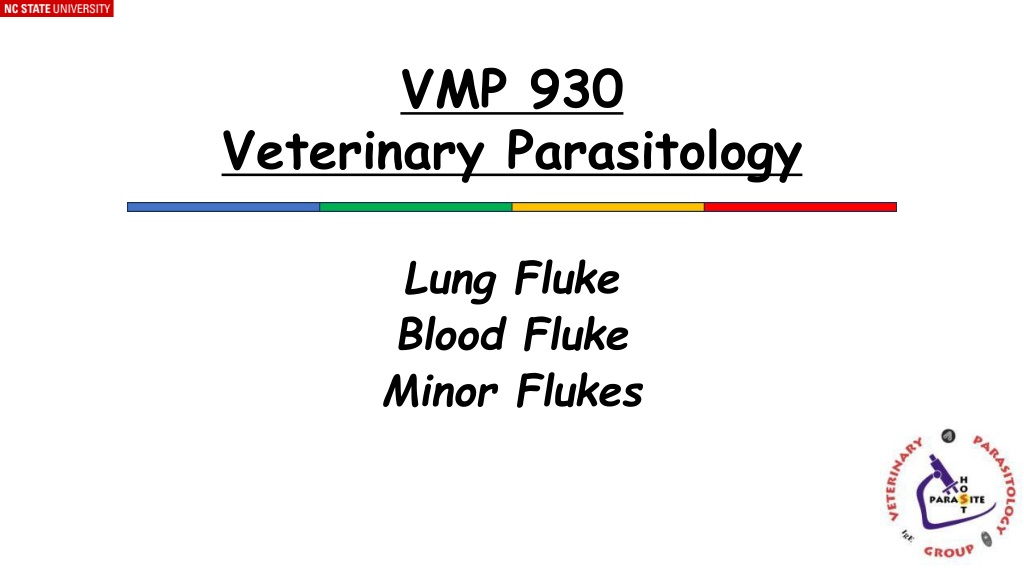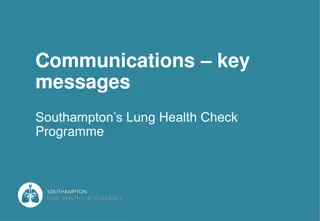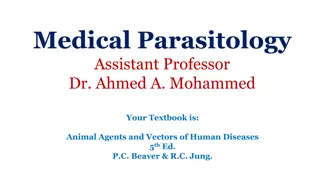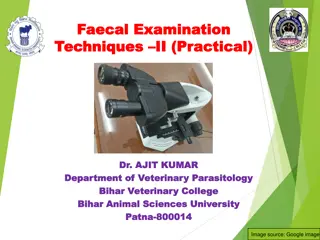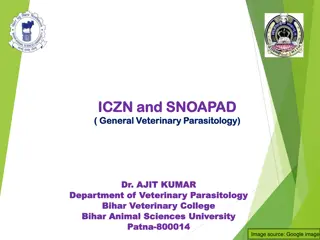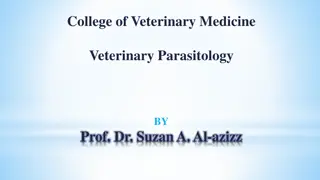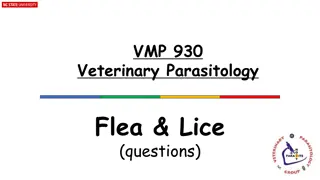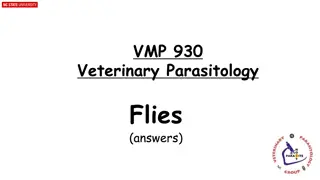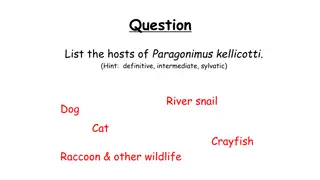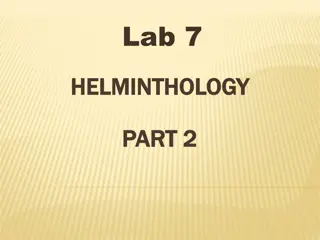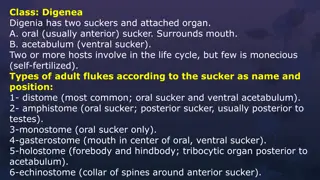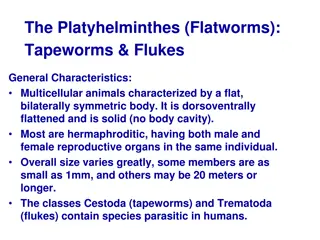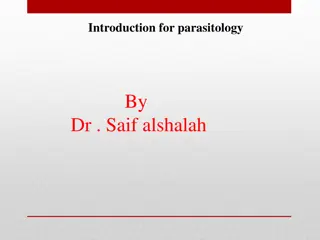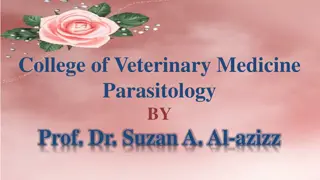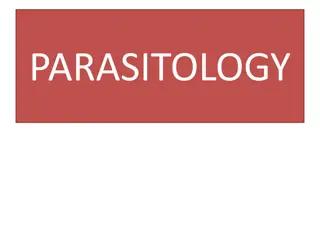Understanding Lung and Blood Flukes in Veterinary Parasitology
Learn about Paragonimus kellicotti, a lung fluke affecting pets and humans, its life cycle, pathology, diagnosis, and treatment. Explore Heterobilharzia americana, a blood fluke found in dogs along the Gulf Coast States, with unique characteristics and zoonotic implications. Discover the clinical implications and management strategies for these parasitic infections in domestic and wild animals.
Download Presentation

Please find below an Image/Link to download the presentation.
The content on the website is provided AS IS for your information and personal use only. It may not be sold, licensed, or shared on other websites without obtaining consent from the author. Download presentation by click this link. If you encounter any issues during the download, it is possible that the publisher has removed the file from their server.
E N D
Presentation Transcript
VMP 930 Veterinary Parasitology Lung Fluke Blood Fluke Minor Flukes
Paragonimus kellicotti Lung Fluke of Pets Life Cycle HIGHLIGHTS Aquatic Definitive Hosts -- Dogs & Cats (Pigs, Raccoon, Mink, etc.) Lung Parenchyma River snails 2nd Intermediate Host -- Crayfish Zoonosis Paragonimus kellicotti Wildlife lung fluke in North America Zoonosis has been reported. Human infection from eating raw or undercooked crayfish Paragonimus westermani human lung fluke in orient Geographic Distribution Throughout North America Cases in North Carolina (dogs, cats, mink, raccoons, bobcats)
Paragonimus kellicotti Pathology Bronchiolar inflammation Eosinophilic granulomas in the lung parenchyma. 2 Adult flukes Rare instances of acute Pneumothorax & sudden death Fluke Cysts
Paragonimus kellicotti Diagnosis Sedimentation Clinical signs: lethargy, chronic intermittent cough, "rusty" sputum. Fecal Sedimentation Sputum Smear Radiology: radiographs; CT scan History of possible access to crayfish Rim around operculum CT scan Radiograph [Cysts indicated by arrows]
Paragonimus kellicotti Treatment & Control Praziquantel (Droncit) 23 mg/kg TID for 3 days Fenbendazole (Panacur) 50 mg/kg daily for 10-14 days Albendazole 25 mg/kg BID for 10 days Snail Control (unrealistic) Molluscicides: check government restrictions Environmental Control Restrict access to crayfish (streams, creeks, rivers)
Class Discussion A cat owner, from Hillsborough has brought in her 5-year-old cat to your clinic. She has noticed that her cat has developed a cough and lately has become significantly less rambunctious. The cat is indoor / outdoor and has access to the Eno River. Respiratory Worms? Diagnostics?
Heterobilharzia americana Blood Fluke of Dogs Unique morphology of blood flukes Dioecious elongate flukes. Female resides in the gynecophoric canal of the male. Male Female Geographic Distribution Texas, Gulf Coast States, Georgia, South Carolina, North Carolina Life Cycle HIGHLIGHTS Aquatic Definitive Hosts -- Dogs & Raccoons (wild canids, bobcat, nutria, etc.) Mesenteric veins Ova developed when passed & hatches when it enters water. Pond / puddle snails Skin Penetration (No 2nd Intermediate Host) Zoonosis Swimmer s itch or Swamp itch Human Blood Flukes Schistosoma spp.
Heterobilharzia americana Pathology Adult flukes Minor to no pathology. Ova Eggs lodge in mesenteric venules Infarctions, ischemia, destruction of intestinal mucosa. Intestinal dysfunction that leads to wasting and death. Eggs transported to other organs. Granulomatous reaction in liver and other organs Inflammation & Fibrosis around eggs and egg clusters. Eggs in Blood Vessels Eggs in Intestinal Epithelium Eggs in Liver
Heterobilharzia americana Diagnosis, Treatment, Control Clinical signs: lethargy, anorexia, intermittent vomiting, bloody liquid diarrhea, dehydration. Fecal saline sedimentation or smear. Miracidial Hatching Laparotomy PCR fecal test from Texas A&M http://vetmed.tamu.edu/gilab/service/assays/heterobilharzia-americana History of possible access to water habitats while in endemic areas. Water-Loving Breeds Miracidium Egg Fenbendazole (Panacur): 40 mg/kg daily for 10 days Praziquantel (Droncit): 25 mg/kg daily for 2-3 days Prevent access to freshwater habitats (ponds, lakes, streams, creeks, rivers, ditches, etc.) Infested Habitat (Confirmed)
Acanthatrium oregonense Potomac Horse Fever Fluke Nanophyetus salmincola Salmon Poisoning Fluke FYI FYI Life Cycle -- aquatic Canids (Small Intestine) River snails Fish (Salmon / trout) Pacific Northwest (WA, OR, north CA) Vector for Salmon Poisoning Affects Canids only Neorickettsia helminthoeca Severe pathology - hemorrhagic enteritis (50% to 90% mortality) Life Cycle -- aquatic Bats (small intestine) River snails Caddisflies & Mayflies Horse (dead-end host) Accidental ingestion of caddisflies or mayflies infected with fluke metacercariae that are infected with Neorickettsia. risticii Sporadic throughout US Vector for Potomac Horse Fever - Neorickettsia risticii Colitis diarrhea, fever, depression
Platynosomum fastosum Bile Duct Fluke of Cats Eurytrema procyonis Pancreatic Fluke of Cats FYI Life Cycle -- Terrestrial Cats (Bile ducts) Land snails 2nd: Roly-Poly bug Paratenic: Lizards or toads FL, HI, Caribbean, Malaysia, South America, Central America, Caribbean, West Africa No pathology mild, temporary inappetence with hepatic dysfunction progressive icterus & possibly death. ("lizard poisoning") Clinical signs: diarrhea, jaundice, vomiting. Life Cycle -- terrestrial Cats (Pancreatic duct) [Raccoons, Fox, Bobcats] Land snails Grasshoppers & Crickets Sporadic (NY, CT, MD, KY, NC) Pathology - Pancreatic duct fibrosis, Pancreatic atrophy Clinical Signs: Vomiting & chronic weight loss FYI
Wellness Break Wellness Break Take a 5-minute wellness break: One More Day -- Eabha ( AVA ) https://www.youtube.com/watch?v=DQ45bOPiRnU
